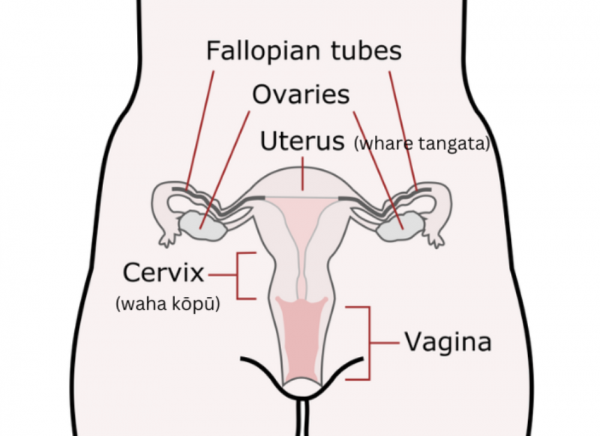Cone biopsy
Key points about cone biopsy
- A cone biopsy is a small operation to remove a cone shaped piece of tissue from your cervix (waha kōpū).
- Your cervix is the lower part of your uterus (whare tangata) that links your vagina to your uterus (womb).

A cone biopsy is one of the procedures performed to diagnose and remove abnormal cells from your cervix. It's usually arranged following a colposcopy appointment where your cervical screening test (smear test) or colposcopy has shown abnormal or pre-cancerous cells. Sometimes a cone biopsy is performed to treat an early cervical cancer.

Image credit: Open clipart
A cone biopsy is performed under general anaesthetic (you are asleep) in an operating theatre. It's usually performed by a gynaecologist.
- You'll be given instructions about when to stop eating and drinking. Usually you need to stop eating 6 hours before you come in and stop drinking water 2 hours before you come in.
- The procedure is usually a day case procedure meaning that you can go home on the same day. You'll need to have an adult with you the night after the procedure.
- During the procedure, a cone shaped wedge of tissue is removed from your cervix. Some stiches may be put into your cervix to stop any bleeding. These stitches are dissolvable and don't need to be removed.
- The tissue is sent to a laboratory where a pathologist will look at the cells under a microscope. They can check that all of the abnormal cells have been removed or can check for cancer cells.
After the procedure
- When you wake up from your anaesthetic you will be in the theatre recovery area. The nurses will monitor your pulse, blood pressure and temperature and check for any vaginal bleeding.
- You may have a pack (like a large tampon) in your vagina. This is to put pressure on your cervix to help stop any bleeding. You might have a catheter in your bladder while the pack is in place. These will be removed before you go home.
- Your healthcare team will give you medication to relieve any pain and discomfort.
- You will be able to eat and drink as normal after a cone biopsy.
- You shouldn't do any exercise for the first week after the procedure. Gentle walking is ok.
In the 4–6 weeks after the procedure
- You can expect light bleeding and discharge after the procedure. This can continue for 4–6 weeks. Seek medical help if the bleeding is heavy or if the discharge is smelly or offensive.
- Don't put anything into your vagina for 4 weeks. This means that you should use sanitary pads rather than tampons or menstrual cups when you have your period. You shouldn't have penetrative sexual intercourse for 4 weeks.
- Avoid swimming, spa pools and baths for 4 weeks.
- You should avoid heavy exercise for 2 weeks after the procedure.
A cone biopsy is a safe procedure and most people don't have any problems afterwards. However, as with any procedure there are some risks. These include:
- Heavy bleeding.
- Infection.
- Increased risk of miscarriage or early (premature) labour in future pregnancies. It's important to tell your midwife and doctor for any pregnancies that you have had a cone biopsy. They will arrange for extra scans to monitor your cervix during your pregnancy.
- Need for further treatment. Sometimes a cone biopsy doesn't remove all of the abnormal cells. If this happens you may require further treatment.
Contact your doctor, and don’t wait for a scheduled appointment, if you have:
- Heavy bleeding requiring you to change your sanitary pad every 2 hours or less.
- A fever (high temperature – 38oC or more).
- Pain in your lower abdominal area that gets worse and doesn't respond to paracetamol.
- Difficulty in passing urine (mimi or peeing).
- A smelly vaginal discharge.
The doctor who performed the cone biopsy will get the biopsy results and will let you know. They will be able to tell you how long the results will take to come through – sometimes it is 4–6 weeks. You may need a follow up appointment to check that the cervix has healed well and for a follow up smear and colposcopy. Ask your doctor what follow up you will need.
Afterwards you usually need to have cervical screening tests more often than usual to check that the abnormal cells have gone and don't come back.
Cervical Cancer(external link) Te Aho O Te Kahu, NZ
Cervical screening resources(external link) Time to Screen NZ
Apps
References
- Treatment of cervical cancer(external link) Cancer Society, NZ, 2021
- Cone biopsy(external link) Cancer Research, UK, 2023
- Cone biopsy patient information(external link) Women’s Health Service, Te Whatu Ora, Capital & Coast, NZ, 2019
- What is a cone biopsy?(external link) WebMD, US, 2022
Credits: Healthify editorial team. Healthify is brought to you by Health Navigator Charitable Trust.
Reviewed by: Dr Judy Ormandy, Senior Lecturer in Obstetrics, Gynaecology & Women’s Health, University of Otago, Wellington and Obstetrician & Gynaecologist Te Whatu Ora Capital, Coast & Hutt Valley.
Last reviewed:
Page last updated:





